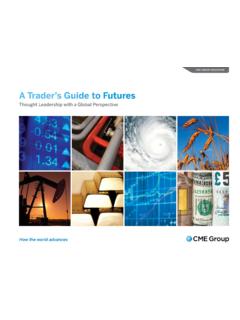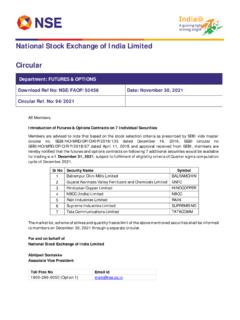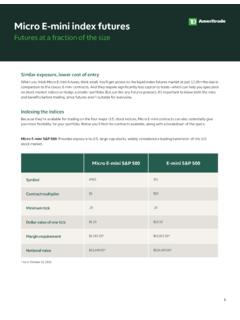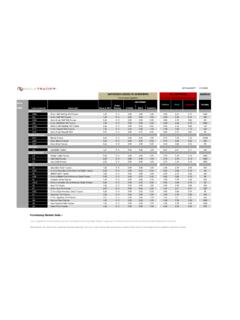Transcription of Forwards, Futures, Options and Swaps
1 Forwards, Futures, Options and Swaps A derivative asset is any asset whose payoff, price or value depends on the payoff, price or value of another asset. The underlying or primitive asset may be almost anything land, stock, interest rates, another derivative asset. Derivative are typically priced using no arbitrage arguments. Arbitrage is a trading strategy that is self-financing (requires no cash) and which has a positive probability of positive profit and zero probability of negative profit. That is, you get something for nothing.
2 The price of the derivative must be such that there are no arbitrage opportunities. A forward contract is simply a current agreement to a future transaction Payment for and delivery of the asset occur at a future date. A forward contract fixes the price of the future transaction the forward price. A futures contract is similar, with the following differences: 1) Futures contracts are standardized for exchange trading. 2) Gains and losses on futures contracts are recognized daily (marking to market). Ex. Consider a farmer with a crop of wheat in the ground.
3 The change in the value of the wheat crop in the ground as a function of the change in the price of wheat is shown in the Figure. As the price rises (falls) the farmer s wheat becomes more (less) valuable. Since the farmer owns the wheat we say he has a longposition in the wheat. Suppose the farmer agrees to sell the wheat under a forward contract at a forward price = the current spot price with delivery upon harvest. the farmer sold the wheat forward, the farmer has a shortposition in the forward contract. future changes in the price of wheat no longer affect the farmer He has fixed the amount of money he will receive for his crop.
4 It is useful however to recognize the changes in value of the crop and the contract separately, even though in this case they offset. The separate gains and losses are shown below. As the price rises, the crop is more valuable But there are offsetting losses in the short position (the farmer sold) in the forward contract. Vice versa when prices fall. The net result is profits are constant as prices change. Recognizing the separate effects on the value of the crop and contract is relevant in cases where the offsetting effect is not perfect.
5 When there is basis risk Forward prices have the following relation to spot prices:*Ft= St(1 + c)T where: Ft= forward price St= spot price c= carrying cost (per period) T= number of periods Carrying costs include: - opportunity costs of holding the asset ( what you could have earned investing the proceeds from a current sale) - storage costs of holding the asset (if any) less any gains from holding the asset ( benefit of an inventory buffer, yield on a financial instrument) which are called convenience yields. The relationship between the spot and forward prices in * is an example of a No Arbitrage condition You can t make a risk-free profit To see this, think about what happens if * does not hold suppose Ft> St(1 + c)T You can sell at Ft, buy on the spot market for Stand deliver in Tperiods.
6 Further, this requires no money it is self-financing. In theory, if *does not hold, you can make an infinitely large profit. But buying on the spot market drives Stup, selling on the futures market drives Ftdown. Limitations of Forward Contracts Credit or default risk: Both parties are exposed to the risk that the other party may default on their obligation. Sharing of strategic information: The parties know what specific risk is being hedged. It is hard to determine the market values of negotiated contracts as these contracts are not traded.
7 These limitations of forward contracts can be addressed by using exchange-traded contracts such as exchange traded futures, Options , and swap contracts. Futures Contracts Exchange traded derivatives cannot be customized (like forward contracts) and are available only for specific assets and for limited set of maturities. A futures contract is a contract to buy or sell a stated commodity (such as wheat) or a financial claim (such as Treasuries) at a specified price at some future specified time. These contracts, like forward contracts, can be used to lock-in future prices.
8 There are two categories of futures contracts: Commodity futures are traded on agricultural products, metals, wood products, and fibers. Financial futures include, for example, Treasuries, Eurodollars, foreign currencies, and stock indices. Financial futures dominate the futures market. Similar to forward contracts, firms can use futures contract to hedge their price risk. If the firm is planning to buy, it can enter into a long hedge by purchasing the appropriate futures contract. If the firm is planning to sell, it can sell (or short) a futures contract.
9 This is known as a short hedge. There are two practical limitations with futures contract: It may not be possible to find a futures contract on the exact asset. The hedging firm may not know the exact date when the hedged asset will be bought or sold. The maturity of the futures contract may not match the anticipated risk exposure period of the underlying asset Basis risk is the failure of the hedge for any of the above reasons. Basis risk occurs whenever the price of the asset that underlies the futures contract is not perfectly correlated with the price risk the firm is trying to hedge.
10 If a specific asset is not available, the best alternative is to use an asset whose price changes are highly correlated with the asset. For example, hedging corn with soybean future . If the prices of a contract with exact duration is not available, the analysts must select a contract that most nearly matches the maturity of the firm s risk exposure. Managing Default Risk Default is prevented in futures contract in two ways: Margin Futures exchanges require participants to post collateral called margin. Marking to Market Daily gains or losses from a firm s futures contract are transferred to or from its margin account.








